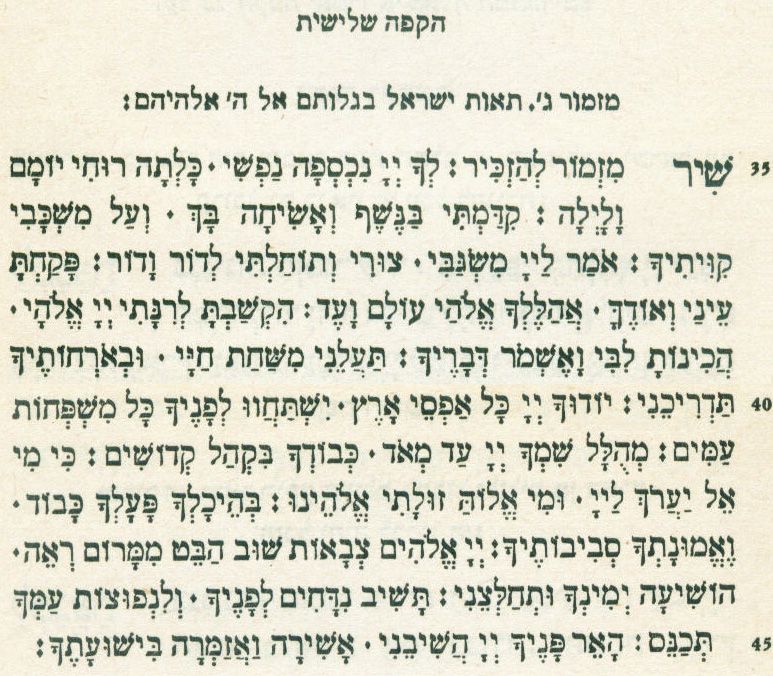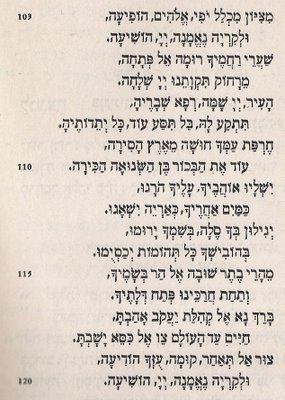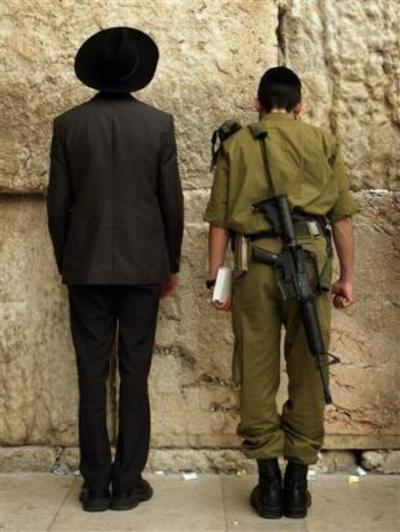Thursday, November 30, 2006
Rare video of Rav Kook and Rav Sonnenfeld!
Posted by chardal at 11/30/2006 10:03:00 PM
Labels: Rav Kook, Rav Sonnenfeld, Video
Sunday, November 26, 2006
Ramchal - 4th Hakafa
Continued from here.
If the last hakafa was one of the activity of man in his degraded state. This hakafa represents a return to passivity:
If the lessons that are to be learned from the exile are embedded into our hearts, we realize that all activity must reflect and show to the world how the Will of Hashem is all that truly acts in the world in the world. Our activity is only a channeling of that will and must never obscure people’s ability to see Divine providence on the world stage. However, this is a different passivity than that which is shown in the second hakafa. There we had the passivity that can only hope for a far-off ideal. Here we have a passivity that hopes for the concrete realization of that ideal and all the stages that lead up to that realization.
This is the first explicitly messianic chapter and it represents the desire of the destitute to see the historical transition from their lowly state to the elevated one. Visions of world justice and the universal recognition of Hashem abound. This chapter is right in the middle of the Hakkafot and thus rightly represents a pivot-point in the consciousness of the nation. The rest of the hakafot are of a different stage in world history. They represent the ultimate result of us understanding the messages of the first four. In the next hakafa, we already celebrate what will be in the future, when the events of this hakafa are complete. Thus, the Ramchal brings us to the present in four hakafot – possibly recognizing that the eternal nation who celebrates with their eternal Torah, can celebrate the inevitable result of world history before it even occurs. It is quite amazing when you think about it – a nation which celebrate in a concrete manner that which most of the rest of the world are not even convinced exists in the potential – in the end, however, that is what we are, the Am HaNetzach, and we must act accordingly.
Posted by chardal at 11/26/2006 09:13:00 PM
Labels: Ramchal, Simchat Torah
Wednesday, November 22, 2006
Well, at least we have a security fence VI
Continued from here.
Well, after spending $1,000,000,000 on a security fence and destroying the lives of 10,000 precious Jews, channel 10 (reported in jpost here) wakes up to discover that the fence does not accomplish a thing:
Entire segments of the security fence near Jerusalem have been breached, allowing dozens of Palestinians to enter the country from the West Bank on a daily basis, Channel 10 reported on Monday evening.
According to the report, no fence remained at all for a stretch of some eight kilometers, and every meter or so, the upper part of the fence was bent.
Holes in the barrier were noted approximately every 100 meters, and the alarm system had been disconnected.
The discovery raises the question of the effectiveness of the barrier, which was built to keep terrorists from infiltrating the country.
Well, Neftuli, this is the 6th post on the topic. Are you ready to concede this point yet?
Posted by chardal at 11/22/2006 02:38:00 PM
Labels: Politics, Security, Security Fence
Monday, November 20, 2006
Lubavitchphiles unite
AddeRabbi has a great short post (funny and sad simultaneously) on the legacies of Lubavitch on the one hand and Satmar and Ponovitch on the other.
I always found it telling that there is so much anti-Habad sentiment on the web - it truly unites the yeshivish and the modern in many ways. I was never a part of it however. I, among countless others, probably owe my teshuva (at least partially) to Habad and their near boundless Ahavat Yisrael. On the other hand, my few encounters (before I was religious) with people claiming to represent the ideologies that most vehemently opposed Habad always left me with a strong desire to stay as far away from the religious world as possible.
Thus, it is not so surprising to me to see the way the detractors are handling their own succession issues.
Warning to commenters, any anti-Habad rhetoric which I subjectively feel passes the bounds of respect due to the movement will be deleted.
Posted by chardal at 11/20/2006 11:51:00 AM
Labels: Chabad
Rare Ramchal play now on the Net!
The Ramchal, among other things, was a playwright. For many years, his plays had been hard to get a hold of. Well, Now the Ben-Yehuda project has made available Migdal Oz - the most famous of the Ramchal's plays - online!
This play was written by the Ramchal for performance at Rav Yeshayahu Bassan's (the Ramchal's Rav in Kabbalah) wedding. It was written in 1727 when the Ramchal was only 20 years old. The early maskilim tried to "adopt" the Ramchal as the father of secular Jewish literature. However, careful reading of these plays shows an underlying mystical-religious theme which is really there in all of the Ramchal's work (this was brilliantly shown by Prof. Shimeon Ginzburg z"l in his work on the Ramchal). Anyone who is aware of the Ramchal's view of the world would immediately realize the absurdity of conceiving of the Ramchal as someone who lived life while conceiving of a divide between the secular and the Divine.
In any case,
Enjoy!
Posted by chardal at 11/20/2006 10:31:00 AM
Labels: Ramchal
Wednesday, November 15, 2006
Ramchal - 3rd Hakafa
Continued from here.
The third Hakafa is a continuation of the second:
The necessary passivity of exile must give birth to some kind of mental or physical activity. To the Ramchal the first active element of exile must be the longing for the Divine. The relationship that was lost must be grieved over and the soul must actively express the longing for that which was lost.
The chapter is filled with imagery of man in his lowest state reaching out to the Divine. To the Ramchal the first lesson that exile must teach us is to appreciate the fundamental essence of the relationship between the Jewish people and Hashem. Playing on the lessons of the first and second hakkafot, the poet rises from passivity to declare his desire for the ideal. The desire is for the restoration of the relationship in both the intimate and private sphere as well as the public sphere. The poet declares ‘as I lay I hope for You’ as well as ‘all nations shall bow to You.’
This poem is one of activity after forced passivity and will be followed in the next hakafah by the expression of the desire to see Hashem remove the hindrances which keep us passive. The activity of the Jewish people in the mental/emotional sphere is followed by the desire to see the activity of Hashem in the world as we once again descend into passive mode.
Posted by chardal at 11/15/2006 05:43:00 PM
Labels: Ramchal, Simchat Torah
Tuesday, November 14, 2006
Ramchal - 2nd Hakafa
Continued from here.
In the second hakafa we descend into our own reality. The full pain of galus is confronted in all its lowliness:
More humble. Less proud. The nation has to distill the core of the message while being stripped of all its institutions. The tone is more pleading than the first hakafat but even in exile the nation must be aware of its internal nature, but in a lower tone – “May Your eyes turn towards the faithful, and may You have mercy over the humble.” We recognize the ultimate justice of Hashem and ask that he have mercy on us. The tone is more passive just as the nature of exile is passive.
This is the direct opposite pole of the first hakafa. If in the first hakafa we want to instill awareness of our special active nature, in the second we must inculcate the idea the human activity by itself can never lead to redemption. We must realize that there is Divine providence which guides the world and that our actions must be in sync with that providence so that together, our action and Hashem’s providence will bring the world to its perfection.
We shall see in the third hakafa how this passivity must turn into active longing for Hashem. That, however is for another post.
Posted by chardal at 11/14/2006 07:30:00 PM
Labels: Ramchal, Simchat Torah
Monday, November 13, 2006
Ramchal - 1st Hakafa
Continued from here.
The first Hakafa is joined by a chapter from the tehillim of the Ramchal:
The chapter starts by pointing out the impossibility of adequately expressing the greatness of Hashem. “Who will tell Your praise Hashem?” and the answer “We are Your servants, Hashem, You have made us. We will say Your Truth for all eternity! Together we will bless You!”
To be able to function as an individual one must be self-aware. One must know their abilities, their limitations, and their purpose. The same is true for the nation. A nation must know its special and unique nature in order to function properly. Thus the Ramchal has us declare that we are a nation whose ability and purpose is to declare the praise of Hashem in this world.
This hakafa is a set up for all the others. It is a mission statement that should make us aware that we have a task which no other nation can fulfill. We must make sure that Hashem’s name is praised through our national and communal life. This is something that the chapter seems to imply is only possible when we function as a national unit. This chapter represents our desire in its most ideal. We shall see that later hakafot are more aware of the limitations of reality but not this hakafa. One must start on a journey fully aware of what SHOULD BE. Only such awareness can give one the strength to engage reality in all its imperfections.
I will try to continue this series for the rest of the week. (I am just curious. Is anyone interested in this or does it just interest me?)
Posted by chardal at 11/13/2006 09:21:00 PM
Labels: Ramchal, Simchat Torah
Sunday, November 12, 2006
Ramchal - before the hakafot begin
In light of my previous post on the Ramchal’s simchat Torah service, I thought I would start a series of post regarding the entire service the Ramchal innovated for the evening hakafot.
What we have left from the Ramchal is mostly his later writings. The vast majority of his most original and profound work was lost to us due the Herem of the Rabbis of Venice who succeeded in driving his esoteric and eschatological writings out of the public eye. One of the works which is lost to us is a “sefer tehilim” that the Ramchal composed in biblical Hebrew. We are lucky however that several chapters of this work made their way into liturgical writings which survived the ban. Out of the 150 chapters, only about 13 have survived and the Ramchal’s simchat Torah liturgy preserves 7 chapters in their entirety. I would like to attempt a series of post which will analyze the Ramchal’s approach to simchat Torah in light of the liturgy which he composed.
I would like to start with the following supplication, composed by the ramchal for recitation after the evening service is complete:
The recurring theme in this prayer is the choseness of the Jewish people and our collective experience as a Divine nation. The prayer also focuses on the special relationship between the Jewish people and Hashem, accentuating how the relationship is stronger than the one between Hashem and the other nations of the world. Special emphasis is given to the special providence which the Jewish people merit in this world – even in the state of exile. The prayer seems to also be very cognizant of our current state of exile and its theological implications.
What is missing from this prayer (and from that matter from the entire service) is any mention of the Torah. The entire service is completely involved with the nation and its relationship with the Divine. Even the type of personal relationship with the Divine whose achievement is the central focus of Messilat Yesharim is almost completely missing from this liturgy.
It seems that to the Ramchal, the national celebration of the Torah must reflect our national nature. Further – The joy of the day must not be achieved through the external aspect of the Torah as a separate entity but rather as the celebration of the Jewish people as a “Torah nation”, a nation whose very national soul is identical with the spirit of the Torah.
In my mind, I try to imagine how the Ramchal would see the act of circling the bima holding sifrei Torah. I do not think that he would view the ritual as an act of the Jewish people showing respect to an external revelation but rather as a conflation of the sefer Torah with the Jewish people who together experience joy as they start to realize that they both represent the imprint of the infinite upon this coarse and finite world.
Hopefully, as we go through the 7 hakafot, we will find even greater clarity and insight into how the Ramchal saw the holiday as one of both national and eschatological significance.
Posted by chardal at 11/12/2006 08:45:00 PM
Labels: Ramchal, Simchat Torah
Tuesday, November 07, 2006
To the process of ideas in Israel
MevaseretZion has a great summary of Rav Kook's masterpiece, "To the process of ideas in Israel."
Check it out!
Posted by chardal at 11/07/2006 08:02:00 AM
Labels: Rav Kook
Monday, November 06, 2006
Ramchal on Simchat Torah
This is a poem the Ramchal wrote to be included in the Simchat Torah liturgy after the 7th hakafah. Read it carefully. The ramchal saw the hakafot as being expressive of the desire of the Jewish people to return to the land of Israel and see it rebuilt.
The hakafot may have been seen by the Ramchal as a re-enactment of the hakafot that the Jewish people observed before the conquest of Yericho. The ritual may demonstrate that the the ultimate purpose of Torah is not just abstract thought but also to bring that abstract thought down into the world.
In other words, the purpose of simchat Torah to the ramchal was not simply to have abstract joy engendered by the Torah but rather to channel that joy towards real spiritual and physical goals.
How do you understand this poem in light of the traditional theme of simchat Torah?
Posted by chardal at 11/06/2006 09:34:00 PM
Labels: Ramchal, Simchat Torah
